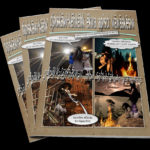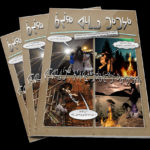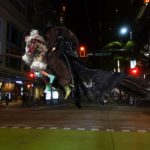KIRKUS REVIEW
https://www.kirkusreviews.com/book-reviews/eelonqa-k-harris/nighthawk-and-little-elk/
In this debut graphic novel, two siblings escape their foster mother and survive in the woods on wits, magic, and love.
Brother and Sister are First Nation children who live in a tightly knit community. One cruel day, they’re abducted and placed in foster care. Their new mother is Thoxweya, a witch from a lineage descended from the original woman of that name who lured children into the woods to eat them. In their new home, Brother and Sister become servants to Thoxweya and her daughter. When the siblings decide to run away one night, the witch curses all surrounding sources of water. While traveling through the woods, Brother tries to quench his thirst at a fountain, then a brook. Sister’s closeness to nature helps her hear the warnings, and she stops him. But eventually, he drinks from a spring and transforms into an elk. Brother and Sister come to terms with their new dilemma and choose to stay strong. They build a shelter in the woods of their people’s ancestral land, surviving on berries, roots, and mushrooms. Brother wears their grandmother’s locket around his furry neck for strength, but is it enough to protect him from a nearby camp of hunters? In this charming, educational tale, Harris uses bits from the Brothers Grimm (“Brüderchen und Schwesterchen”), the actual legend of Thoxweya, and her own fiction to illustrate sustainable living choices. Vibrant photography—especially the outdoor scenes—provides backgrounds while meticulously crafted dolls act out the script. Light digital effects add personality to the figures and magic to the transformations. At the end of the story, the author emphasizes underlying themes for her younger audience with a mock-up article titled “We Need to Protect the Planet We Depend On.” Boldface phrases, such as “vote with your pocket book,” “insincere politics,” and “even if it’s inconvenient and hard,” are ones adults should discuss in detail with children. Harris’ wisdom applies to readers of all ages: “Everyone should keep a vigilant eye on the goings-on in the world outside their own small one.”
A quirky and vivid primer for parents to teach kids about environmentalism.
Official Review: Blueberry Boy by eelonqa K harris
https://forums.onlinebookclub.org/viewtopic.php?t=94023
In this debut graphic novel, two siblings escape their foster mother and survive in the woods on wits, magic, and love.
Blueberry Boy by Eelonqa K Harris is a graphic novel about an eight-year-old boy with a disorder. Blueberry Boy is deeply loved by his family and friends, but others make fun of him because he has trouble saying the right things. Blueberry Boy tends to keep to himself, but his limitation helps him become more aware of the world. He notices a selfish leader who is a terrible bully, and he sees many adults choosing to emulate this leader. Blueberry Boy believes people should be kinder and more generous, but how can one boy change the behavior of adults around the world?
This is an important book for multiple reasons. Blueberry Boy includes themes related to identity, community, global events and bullying. The author’s ability to touch upon all of these subjects with great detail and limited text is illuminating. Additionally, Blueberry Boy is Coast Salish, an indigenous group rarely represented in mainstream media. Many young children will find the main character relatable, especially children who feel marginalized by societal norms.
Although the messages in this book are important, the meticulously crafted illustrations are what set it apart from others in the genre. As with most graphic novels, the author relied mostly on illustrations to tell the story. In Blueberry Boy, Harris used photographs of real-life settings. However, the characters in the photographs are unique. Harris inventively fabricated avatars using a mixed-media approach. Action figurines, alpaca hair, 3D printed garments, and photographs of people from the author’s First Nation community were all used to create the avatars that gave the story life.
Additionally, each image found in Blueberry Boy is complex. For example, one page of the book describes how the protagonist was bullied. Though the text on the page is brief, the illustration speaks volumes. Blueberry Boy is shown sitting against a building with a forlorn expression. Behind the boy are shadows that depict the bullying he previously endured. I was fascinated by the author’s use of positive and negative space and the juxtaposition of the static image of Blueberry Boy against the active image of the shadows.
Blueberry Boy is an exceptional book, and I liked everything about it. The inventive artwork coupled with the powerful story make this a must read. Further, the book is perfectly edited. Since I was blown away by the imaginative images and poignant story, I rate Blueberry Boy 4 out of 4 stars. This book may appeal to a wide audience. The protagonist is eight, so children around that age will relate to this book and its themes. However, I also recommend Blueberry Boy to teens and adults who enjoy forward-thinking graphic novels and unique imagery.
A quirky and vivid primer for parents to teach kids about environmentalism.
Official Review: Eagle Woman’s Bones by eelonqa K harris
https://forums.onlinebookclub.org/viewtopic.php?t=94023
Eagle Woman’s Bones by Eelonqa K. Harris is a picture book that helps explain how cancer works to children. The story centers around two chromosomes, Eleven and Fourteen, who live inside Eagle Woman and help her stay strong. When the chromosomes get into an accident, they somehow swap arms, which prevents them from doing their regular jobs. Because of this, Eagle Woman becomes sick and must seek medical help.
Since I have previously reviewed a book by this author, I expected big things from this one, and I wasn’t let down. The author makes every figure used in the book and takes photos of them to create the scenes pictured. I loved how she interwove the science into both the illustrations and the story by personifying chromosomes. The science included managed to be both generally accurate and at a level that many children could understand. I also liked how the book focused on hope for the future by telling kids that Eagle Woman is seeking treatment and that proceeds from buying the book can help scientists find a treatment that works for her.
My only complaint about this book is that the ending felt a little abrupt. The last page implies that the story will now begin, but then it ends. I felt like this could confuse children who are thinking they will get to know if Eagle Woman has beaten her cancer. However, the author does include a short explanation of her relationship with Eagle Woman, who is a real person, and how she is doing now at the end of the book. This may help kids understand that the story in the book is a real one for many people.
Overall, I would rate this book 4 out of 4 stars. Although I was a little confused by the last page, that doesn’t merit a star being removed, especially because the book appears to have been professionally edited. Between the beautiful illustrations that integrate photos of the characters with digital backgrounds and the age-appropriate messages about the science behind cancer, I can’t find a reason to take away a star from this book.
I would recommend this book for parents of children ages 4 to 10, especially those who have a close friend or family member battling cancer. I think this book would be a great aid in explaining how cancer works in the body and in giving kids hope for the future.
******
Eagle Woman’s Bones
View: on Bookshelves, I also recommend Blueberry Boy to teens and adults who enjoy forward-thinking graphic novels and unique imagery.
A quirky and vivid primer for parents to teach kids about environmentalism.














